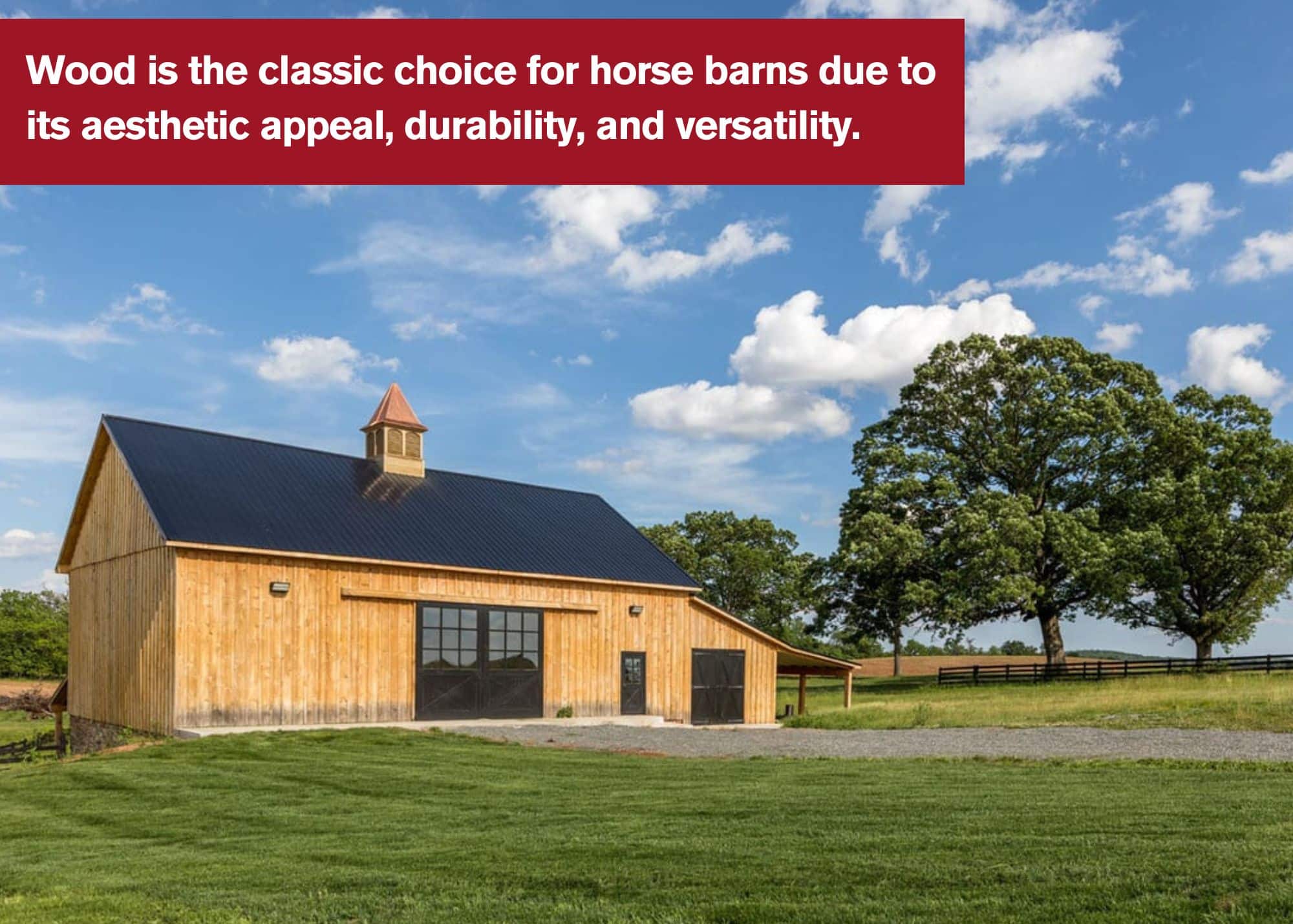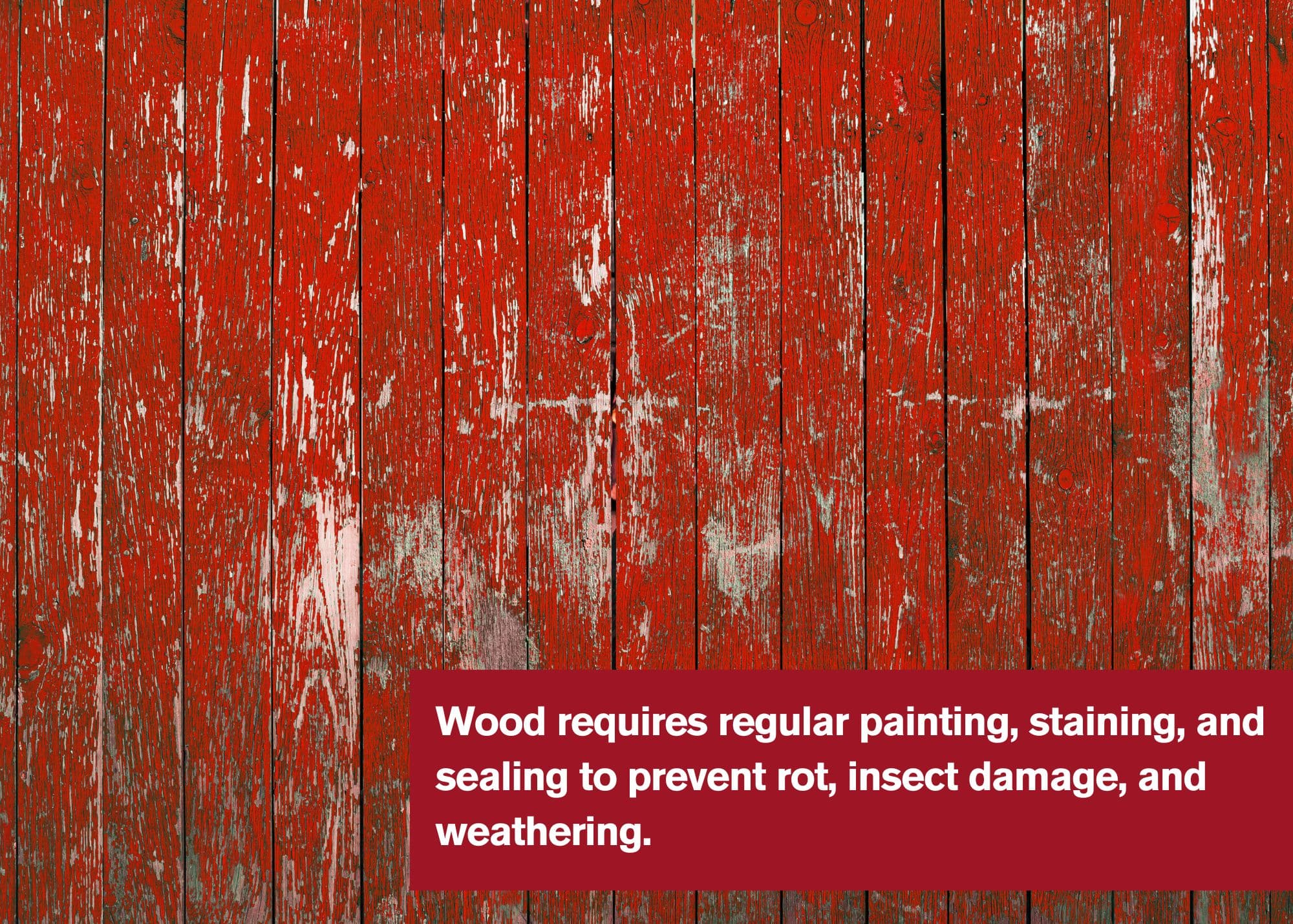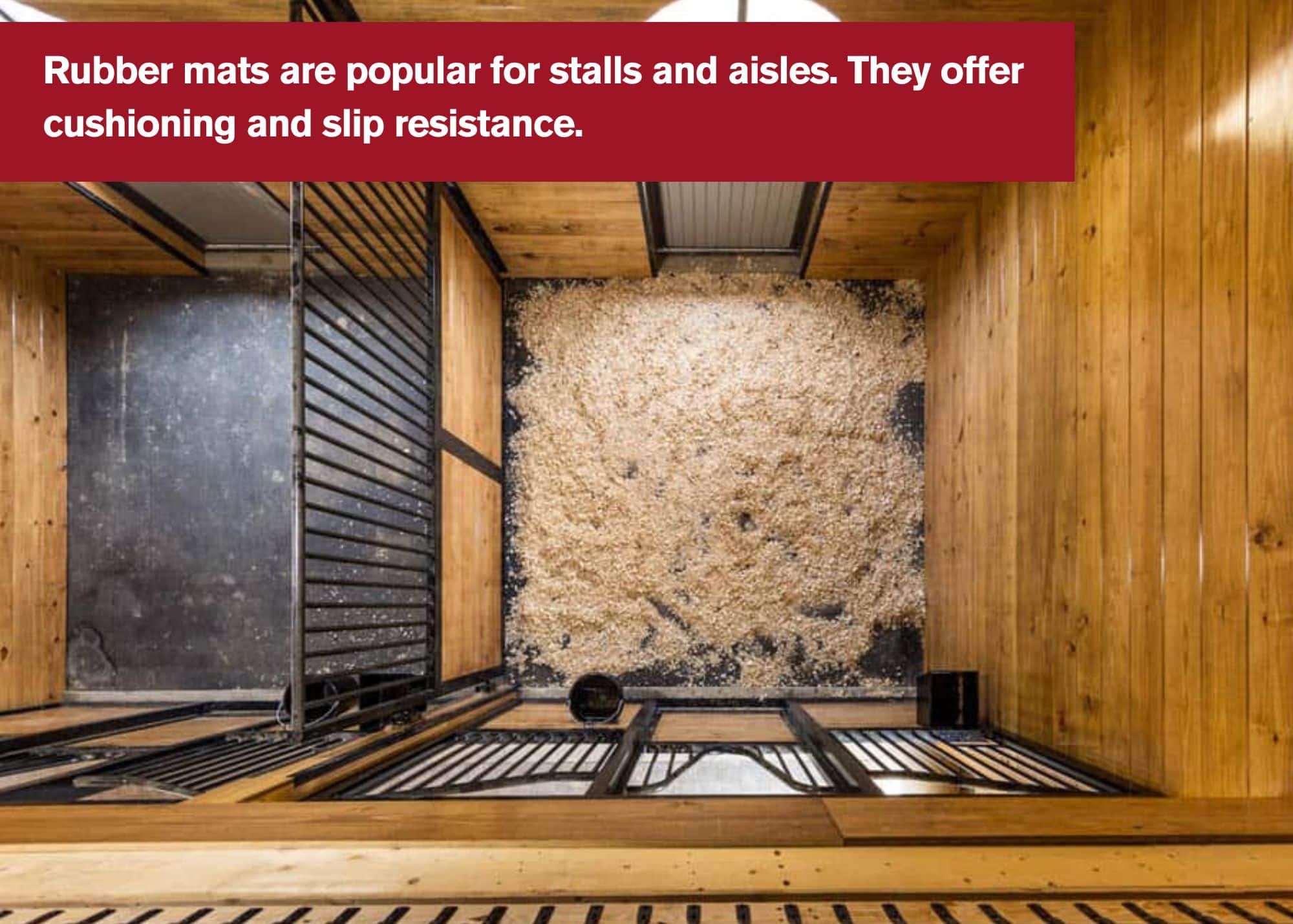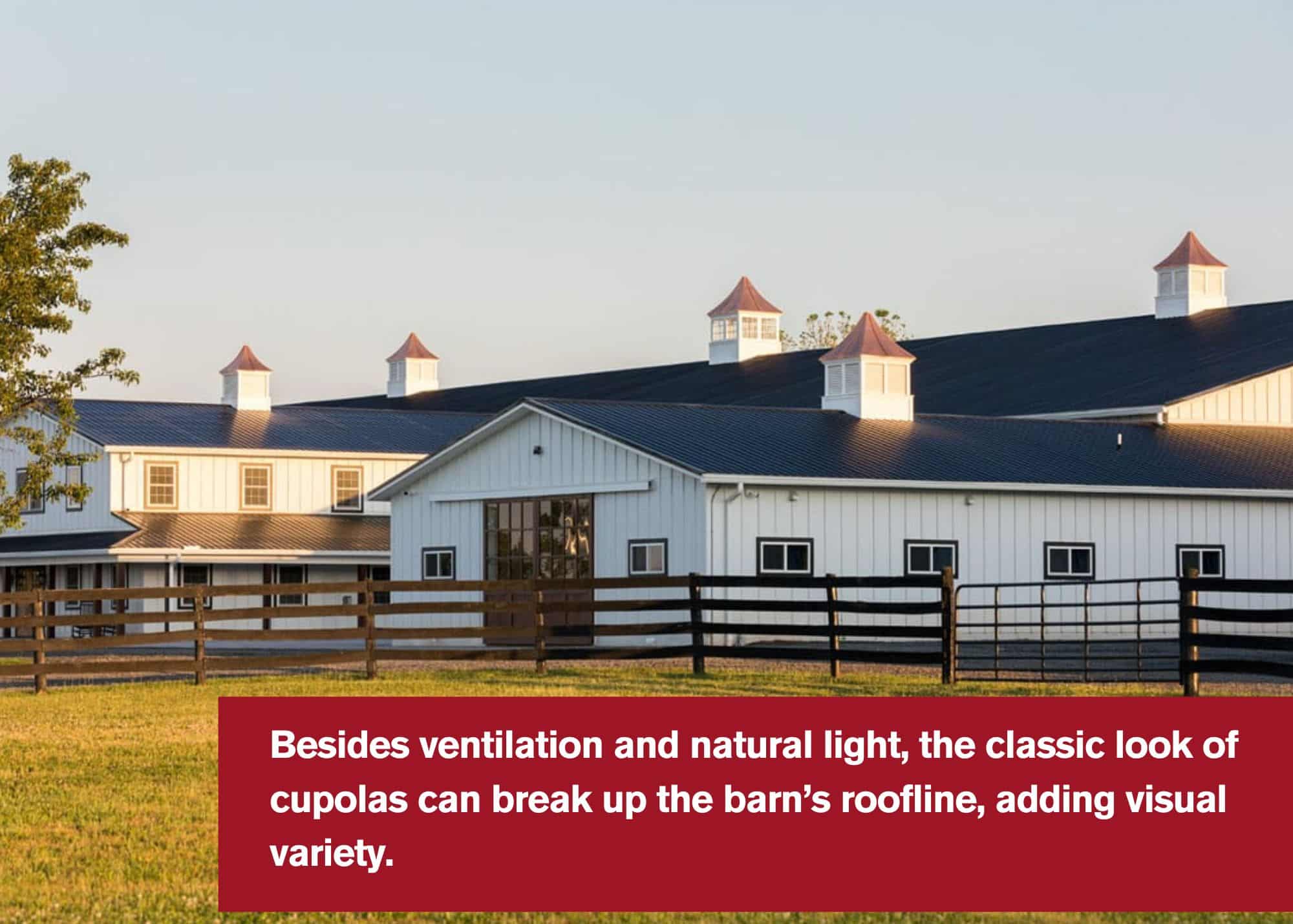A Quick Look at Horse Barn Materials
Table of Contents:
For horse owners, building a safe, comfortable, and functional barn for their animals is a serious matter. A well-constructed barn is not just a shelter for the horses; it’s a home for the horses to safely rest and relax while their humans feed and care for them in a comfortable, covered space.
At Tristate Barn Builders, we understand that every horse owner has unique needs for themselves and their animals. From our location in Newburg, PA, we offer a bespoke barn-building experience in Pennsylvania, Maryland, and Virginia. We emphasize a detail-oriented approach to ensure the final product meets the client’s vision.
In this blog, we’ll discuss the different materials used in barn-building. Each has pros and cons, and a brief discussion should get you started on choosing a barn.
Ready? Let’s giddy-up!
Things to Consider When Choosing Horse Barn Materials
When thinking about building materials, it’s essential to consider the following factors:
- Budget: Different materials have varying price tags. Establishing a budget as a first step will help you narrow your options.
- Climate: The local climate significantly impacts the materials you build with, particularly their durability and maintenance requirements. For example, an area with high humidity may require materials that are more resistant to rot and insect infestation.
- Aesthetics: While the horses wouldn’t give a horse’s rear end, the barn’s appearance is important to many owners. Consider your desired style and how much you will spend to achieve your desired aesthetic.
- Functionality: The barn’s intended use will influence the barn’s material and design choices. For example, a large breeding operation must be designed to keep stallions and mares safe and provide a clean environment for breeding and foaling, compared to a small hobby farm, where comfort and aesthetics are a priority.
- Herd size: A larger herd requires a larger barn. Unfortunately, it’s not as easy as adding the cost of additional stalls, as costs will rise due to needing more material for longer aisles, walls, roofing, windows, and so on. Your barn build must determine the appropriate size based on the number of horses and their specific needs.
In summary, building a horse barn is an expensive endeavor. Meticulous planning at the beginning will help you determine the final form of your barn.
Common Horse Barn Materials
Wood
Wood is the classic choice for horse barns due to its aesthetic appeal, durability, and versatility.

Pros:
- Aesthetics: Wood’s classic, warm look blends well with rural landscapes.
- Durability: A wood barn will last many years, depending on the wood used—a timber-framed barn using traditional joinery results in a robust structure that lasts generations.
- Versatility: Wood can be used for framing, siding, roofing, and interior finishes.
- Customizable: Wood is easily customizable to fit specific design preferences.
Cons:
- Maintenance: Wood requires regular painting, staining, and sealing to prevent rot, insect damage, and weathering.

- Fire Hazard: Wood is combustible, increasing the risk of fire damage.
- Cost: High-quality wood can be expensive, especially for large barns.
- Pest Susceptibility: Wood is vulnerable to termites and other wood-boring insects.
Types of Wood Used for Horse Barn Construction:
- Pine: A cost-effective option that is easy to work with, pine requires regular treatment, such as sealing or painting, to protect it from the elements. Due to its affordability, structural strength, and availability in long lengths, pine is commonly used in stick framing.
- Oak: A strong and durable hardwood that is naturally rot-resistant, oak is popular for outdoor projects. Oak is an expensive hardwood that takes a long time to grow, making it relatively scarce compared to other woods. Its beautiful grain pattern makes it desirable, and it takes skilled craftsmanship to get the most out of it.
- Cedar: Like oak, cedar is expensive because of its natural beauty and durability. It is relatively scarce due to its longer maturation process. Cedar's naturally occurring oils and acids make it resistant to rot and insect infestation.
- Pressure-Treated Lumber: Typically Southern yellow pine, pressure-treated lumber is wood chemically treated to resist rot and insects, extending its lifespan.
Steel
Steel is a low-maintenance, fire-resistant, and long-lasting option for horse barns. Due to its durability and ease of construction, it is becoming increasingly popular.
Pros:
- Low Maintenance: Compared to wood, steel structures require minimal maintenance.
- Fire Resistance: Steel is non-combustible, reducing the risk of fire damage. Even during a fire, it takes exceptionally high heat for an extended period before steel’s structural integrity is compromised.
- Durability: Steel is highly resistant to pests, rot, and other forms of degradation.
- Longevity: Steel barns can last for decades with proper construction and care. The estimated durability of properly maintained steel is 50-100 years, though some steel structures still stand after 245 years.

- Design Flexibility: Steel can be engineered to accommodate various design specifications, including large, clear-span arenas using post-frame architecture, joists, and trusses.
Cons:
- Aesthetics: Some horse owners may find steel barns colder, and contemporary barns may be less visually appealing than traditional wood barns.
- Insulation: Steel is a poor insulator, which can lead to temperature fluctuations inside the barn. There are several ways to insulate a metal building, adding further cost.
- Cost: Steel can be cost-effective in the long run due to lower maintenance, but the initial investment is higher than wood. Fabrication costs, fluctuating prices, global demand, and tariffs increase the cost of steel, even from domestic producers.
- Condensation: Steel is prone to condensation, which can cause moisture problems if not properly managed.
- Rust: Steel can rust if improperly coated or maintained, especially in humid climates.
Other Materials and Considerations
The horse barn’s frame and walls are just the beginning. In addition to wood and steel, several other materials and design considerations can influence the functionality and safety of a horse barn.
Roofing Materials
- Asphalt Shingles: Asphalt is an economical option but not the most durable for horse barns. Severe weather, such as hail, will damage or degrade the shingles and shorten their lifespan to less than 15-30 years than intended.
- Metal Roofing: A durable, long-lasting option that is fire-resistant and can withstand harsh weather conditions. For a more traditional look, stone-coated metal roofing is costlier but mimics the appearance of almost any kind of traditional roofing material. Metal roofing is ideal for mounting solar panels, too.
- Wood Shakes Shingles: Roofing made of wood shake shingles has a beautiful, natural aesthetic that’s hard to beat but is more expensive and will require more maintenance as wood is susceptible to pests and rot, especially in humid climates. Regular inspections and treatments will be needed to ensure the roof’s longevity.
A roof provides shelter to keep your animals dry. During your budgeting process, rank durability, cost, and aesthetics in this order.
Flooring Materials
- Concrete: Durable and easy to clean, concrete can be hard on horses' legs. While cool during the warm seasons, it can be very cold and uncomfortable during the winter. Concrete is also a potential slip hazard when wet, posing a risk to humans and animals.
- Clay: A natural, economical option, clay provides good cushioning but can shift over time, requiring regular maintenance. To allow for good drainage and minimal odor problems, the clay must be placed over a well-drained subfloor of crushed rock or gravel. Clay is essentially a giant French drain and cat litter box combined.
- Rubber or Vinyl Mats: Rubber mats are popular for stalls and aisles. They offer cushioning and slip resistance.

Mats are recommended for maximum cushioning and can be purchased in individual pieces that can be moved about or as custom flooring that covers the entire barn floor.
Take your barn’s flooring seriously, as your horse will spend most of its time standing on it. For a comprehensive look at horse flooring materials, take a look at this blog.
Stall Design and Materials
- Wood Stalls: These offer a traditional, cozy look and can be customized to fit various needs.
- Steel Stalls are robust and low-maintenance, with customization options. They can be combined with wood panels for an attractive blend of durability and aesthetics.
- Mesh or Wire Mesh: Mesh stalls provide good ventilation, visibility, and unobstructed access to natural light but may not be suitable for all horses.
The horse’s stall is a bedroom where your horse can rest and relax. While “spare no expense” applies to everything when building a horse barn, this applies more than anywhere else, as your horse will spend most of its time here.
Ventilation
- Ridge and Soffit Vents: For roofs with long ridgelines, ridge and soffit vents allow warm, moist air to escape from the top of the barn.
- Cupolas: Besides ventilation and natural light, the classic look of cupolas can break up the barn’s roofline, adding visual variety.

- Windows and Doors: Allow for natural ventilation, which can be opened and closed as needed.
- Fans: Sometimes, you just need to give that air a helping hand. A couple of basket fans can help move air in the barn more efficiently, driving out heat and odors.
Good ventilation is crucial for maintaining air quality and preventing respiratory problems in horses. It’s not just for the horses’ benefit—horse flatulence is ferocious!
Insulation
- Fiberglass Insulation: Fiberglass is cost-effective, versatile, and easy to install. However, it is susceptible to moisture damage and can become soggy and ineffective. Fiberglass batting doesn’t naturally create an airtight seal, so a barrier wrap is usually needed to reinforce the insulation.
- Foam Board Insulation: Foam board is a rigid insulation that needs to be installed carefully to prevent gaps. It is a good choice for flat surfaces, such as walls and ceilings, and provides excellent insulation for its thickness.
- Spray Foam Insulation: Spray foam, while expensive, provides excellent and comprehensive insulation, sealing air leaks effectively. Resistant to mold and mildew, spray foam insulation is an excellent long-term solution.
Insulation helps regulate temperatures inside the barn, keeping it cooler in the summer and warmer in the winter. How much insulation you need depends on your local climate and the material the barn is built with. For example, the natural insulation properties of timber may mean you need less insulation, but timber’s higher cost offsets it.

Customization and Design
- Stall Size: The size of your stalls will depend on the size and breed of your horses. Allow some extra space for the horse to move about freely in the stall for comfort.
- Aisles: Wide aisles make it easier to move horses and equipment around the barn. Ensure adequate drainage along the aisle.
- Storage: Adequate storage space is essential for hay, feed, and equipment.
- Wash Areas: Wash areas provide a convenient place to bathe and groom horses.
- Tack Rooms: Tack rooms are secure places to store and organize saddles, bridles, and other equipment.
Customizing your horse barn allows you to create a space that meets your needs and preferences. While these customizations offer great convenience, it’s crucial to prioritize the horses’ comfort.
Conclusion
While any new construction project is an investment, horse barns are unique in that their occupants don’t get a say in what their home will be or look like. It is up to the owner to ensure that everything in the barn is built with the functionality and comfort needed for the horse to have a happy life.
At Tristate Barn Builders, we get that! From beautifully crafted equestrian facilities to recreational and entertainment spaces, we are ready to provide exquisite barns and other solutions to meet your needs. With the finest materials and our signature Amish craftsmanship, we create stunning structures that honor the equestrian aesthetic without compromising detail or elegance.
Contact us today to make your dream horse barn a reality!





